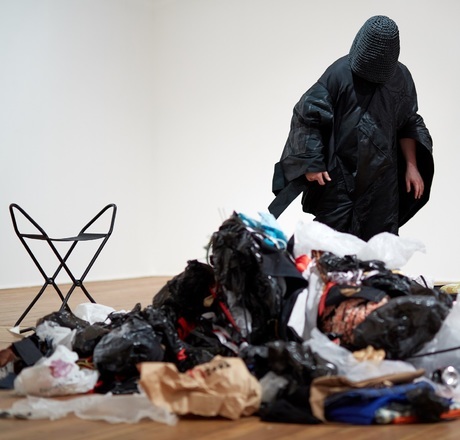
SEPTEMBER 23, 2018 / 3:00 PM—7:00 PM / ROOF OF BUILDING №5
On September 23, Leif Holmstrand (Sweden) will present the performance, “Nonsense Translation,” which will encapsulate his participation in the Zarya Artist-in-Residence program. Made possible with the support of the Swedish Embassy in the Russian Federation and Konstnärsnämnden, Sweden, the presentation will be held on the roof of Building № 5 of the Zarya Factory, from 3:00 pm until 7:00 pm. Entrance is free of charge, but age is restricted to 12+.
Leif Holmstrand works across genres, creating installations, objects and performances, as well as musical or literary compositions. Throughout his work, the artist makes frequent reference to shamanism and its contemporary rethinking. The culminating work of his residency, the performance “Nonsense Transition” offers a new perspective on research into this topic.
As in the majority of his previous performances, here Holmstrand develops a system of rules that will be followed throughout the duration of the action. The gestures produced by the artist vary, though they share the same objective: through interaction with set materials—in this case, household waste, garbage, textiles and clothing, threads, ropes, etc.—Holmstrand constructs a new “body.” Over the course of the performance, the artist will create an enormous textile object, a totem or talisman. The artist will leave the performance open-ended. This means the object might be complete, or it might remain in a state of construction, or it might even envelop its creator, ultimately ensnaring him within its complex structure. The scenography will draw from readymade elements of installations, sculptures, or, as the artist calls them, “non-magical transcendental objects,” created from old clothes or crocheted.
The selection of these specific materials is not accidental. Holmstrand confesses that since childhood he has been obsessed with fabrics, knots, ropes, weaving and knitting, which symbolize both a defense (like a cocoon) and a trap or a threat. He is additionally intrigued by the aspect of time in the process of knitting, and the sensation that something is growing organically with every added eyelet. In many of his works, Holmstrand uses different kinds of garbage, collected in the city. The artist consid ers this waste to be a reflection of urban life, allowing it to be read like the materialized voice of local culture, as well as abandoned, unwanted little bodies.
The soundtrack for the performance will be provided by one of Holmstrand’s musical pieces, RINGS DRAPA, which is based on an old Romantic poem by Swedish poet Esaias Tegnér. The rhythmic text is almost entirely transformed into sounds that seem to lack any relationship to language, with each of the various sections of the piece having their own distinct sound. This poetry-as-music accompanying the performance becomes a kind of melodious incantation, charms comparable to shamanic ritual. However, it should be noted that Holmstrand’s pseudo-shamanic practice has nothing to do with religion or magic. On the contrary, the artist emphasizes the lack of any magical character in his performances, offering them as a kind of secular, urban-animist shamanic ritual of construction.
In this performance, the artist will also reflect on his impressions of Vladivostok. To some extent, “Nonsense Translation” can be seen as illustrating a fragment of this city’s fluid, multinational, multicultural history as well as its present. Holmstrand was particularly influenced by the objects on display at the Arsenyev Museum, which inspired him to create the textile sculptures for the performance.
*Leif Holmstrand (born 1972) is an artist and writer from Malmö, Sweden. His practice as a sculptor and creator of visual images is multifaceted and includes several different stylistic approaches. For instance, his textile objects are supplemented with assemblage from pieces of furniture, as well as digital photocollage, sound installations and performances. The hierarchy of materials in his works is never clear, as for him even expensive silk has the same basic decorative function as household waste and found objects. Another important influence on his work has been his collaborations with Japanese artists and other cultural figures. For more about the artist, refer to his site: http://www.leifholmstrand.se